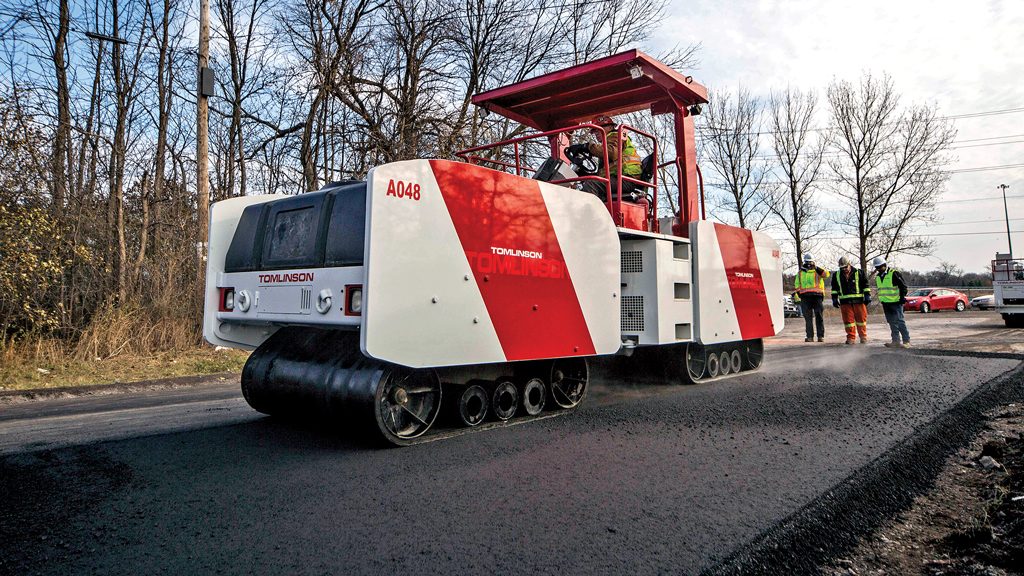Road engineers are looking at road life cycles from the wrong end of the pipe, says a Carleton University professor.
The real issue is where the rubber meets the road — as in using a rubber track to compress the asphalt rather than the traditional road rollers, says A. O. Abd El Halim, Carleton civil and environmental engineering professor and director of their infrastructure protection and international security master program.
He says ideas to use asphalt mixes as a dumping ground for cigarette butts, ways to dispose of used tires, left over paint or even printer toner, simply treat roads like garbage.
It’s not the mix, he says, it’s the application.
“Roads are precious, we need to nurture and respect them because they are essential,” he says.
“We can’t use them as dumping grounds.”
It also comes down to cost. The United States spends $3 billion annually fixing potholes and the Ministry of Transportation Ontario’s (MTO) own research shows extending highway life cycles by just a year, could save $50 million annually.
The better way to ensure robust life cycles is to change the way the surface is finished, he insists.
To that end, nearly 40 years ago, he invented a road rolling machine which uses a rubber belt which, he says, will guarantee up to seven years of problem free surface while life cycles could also see 20 or 25 years with simple shave and paves using the machine again to compact the top surface.
“No contractor is guaranteeing that right now,” he says.
“Right now they use several types…one a smooth steel drum, an oscillating drum and the third, with pneumatic tires. They have to make between 15 and 25 passes but with my roller you can do it in six.”
The difference is in the finish, he says. Unlike traditional rollers, his rubber tracks leave no cracks which expand and contract with heat and cold and allow water seepage which leads substrate disruption and potholes.
Road builders and engineers across the globe have been searching for the perfect combination. In Australia cigarette butts are being used as fill, not so much for performance properties but to safely dispose of the toxins secreted in the fibres.
Australian researchers at the city of Melbourne shovel nine million butts into landfill annually. Mixing them in asphalt not only traps the toxins but offers some insulation value, offsetting heat radiation from roads in cities.
Over in Sydney they’ve imported another Melbourne concept — using toner waste in road. TonerPave uses recycled toner and claims its 40 per cent more energy efficient than bitumen offsetting 270kg of CO2 emissions per tonne.
TonerPave replaces 600kg of bitumen and 400kg of fine aggregates, such as sand and soil.
Each toner cartridge still has 13 per cent of its load when it is disposed off and 100 cartridges will create one tonne of TonerPave. There’s already enough toner being collected in Sydney to meet double the city’s needs.
All this innovation, however, doesn’t do much to extend the life cycle of a road and that’s where the critical issue lies, says Halim.
We really haven’t changed the way we finish roads since the Victorian era,
—A. O. Abd El Halim
Carleton University professor
“Essentially we have changed many things about road building but we still end up with the same problems,” explained Halim.
“We really haven’t changed the way we finish roads since we first started building roads in the Victorian era, we still roll over them.”
But at between $500,000 to $750,000 each, traditional rollers are a long term investment and contractors are understandably reluctant to switch gears and invest in new and as yet widely tested and accepted equipment.
His machine, the Amir, was named after his son, he says because he wanted not just to express his love as a father but to show his love for roads.
Uptake, however, has been, flat. It was used to build some roads for the Australian Olympics in the 1990 and in 2012 used on some bridge projects in Ontario. More recently in November 2017 the City of Ottawa used it to test a section of roadway.
MTO has also provided $350,000 to Halim’s research. To take the concept to the next level Halim has teamed with Tomlinson Group in Eastern Ontario to patent a retro-fit roller kit compatible with common road rollers.
“It won’t cost $500,000 that is for sure,” says Prof. Halim. “It is an option for someone with a machine they are not using or needs roller maintenance.”




Recent Comments
comments for this post are closed